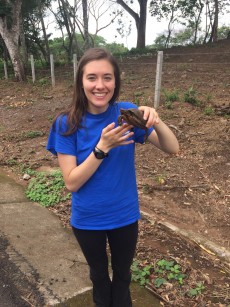Reforestation in Costa Rica: Setting Precedents

Brittany Schweiger
Department of Biology
Lake Forest College
Lake Forest, IL 60045
This summer, I had the amazing opportunity to work with the Monteverde Institute in Costa Rica. My internship revolved around collecting data for ongoing reforestation studies. I worked closely with individuals who care deeply about the replenishment of Costa Rica’s lost forests and the organisms affected by these losses. My favorite moment during the three months I spent in the Monteverde Zone was helping plant over 300 saplings in a pasture. It’s one thing to simply talk about reforestation, but it’s another to be a part of planting the next generation of forests. I like to think that someday I can help change how our planet is treated, but for now, I’ll settle with spreading the success story of Costa Rica’s forests.
Between the 1950s and 1980s, Costa Rica suffered the fastest deforestation rate of any Central American country (Lopez, 2013). In just three short decades, Costa Rica’s forest coverage decreased from 75% of the land to only 21% (Lopez, 2013). However, since that time, many reforestation efforts have commenced and now, Costa Rica is considered a leader in environmental sustainability (Lopez, 2013).
The government and individuals alike have contributed to save the rainforests. The Payment for Environmental Services (PES) is a governmental program that pays landowners for each hectare of protected forest (Lopez, 2012). In the 1980s, a worldwide campaign – led by elementary school children – raised money to protect what is now known as the Children’s Eternal Rainforest. It currently boasts 22,500 hectares of protected primary and secondary tropical forest (“The Children’s Eternal Rainforest,” n.d.). The Bellbird Biological Corridor (BBC) is another organization invested in reforestation; the BBC aims to connect patches of forests from the Monteverde Zone to the Gulf of Nicoya with the cooperation of the local population. In addition to reforesting the tropical forest, the BBC will also provide wildlife with natural areas to live and migrate, especially the endangered Bellbird (“Corredor Biológico Pájaro Campana,” n.d.).
The idea for the Bellbird Biological Corridor began in 1992 with a project that identified conservation gaps around Costa Rica (“Corredor Biológico Pájaro Campana,” n.d.). A biological corridor aims to create a connection between landscapes to ensure the preservation of biodiversity and ecological processes (“Corredor Biológico Pájaro Campana,” n.d.). Costa Rica holds 95% of the world’s biodiversity on merely 5% of the land surface. Many species within this 95% are endemic to Costa Rica, including the Three-Wattled Bellbird. However, the Bellbird Biological Corridor does not positively impact just the bellbird, many other endemic and migratory species also benefit from this biological corridor. The BBC estimates that 50% of Costa Rica’s terrestrial vertebrates will be represented in the Corridor (“Corredor Biológico Pájaro Campana,” n.d.). In addition to the mammals, 51% of the birds and 47% of the reptiles in Costa Rica fall within the species represented within the BBC (“Corredor Biológico Pájaro Campana,” n.d.).
Costa Rica was on the fast track to eliminating their natural environments. Through the implementation of various government and NGO programs, the degradation of these forests was able to be reduced tremendously. However, the development and enforcement of these efforts, such as the BBC and PES is only part of this success. Without the cooperation and support of the local population, Costa Rica may be known only for their bananas, coffee, and pineapple plantations instead of holding the world’s greatest biodiversity and having more than 50% of its land returned back to forest. Costa Rica is a world leader in environmental sustainability and many nations could learn from their experiences. To me, one of the most important ideas we can gain from Costa Rica’s environmental successes is that change happens on the individual, small-scale level.
Note: Eukaryon is published by students at Lake Forest College, who are solely responsible for its content. The views expressed in Eukaryon do not necessarily reflect those of the College. Articles published within Eukaryon should not be cited in bibliographies. Material contained herein should be treated as personal communication and should be cited as such only with the consent of the author.
References
Bosque Eterno de los Niños. (n.d.). The Children’s Eternal Rainforest. Retrieved from http://acmcr.org/history_ben.htm
Corredor Biológico Pájaro Campana. (n.d.). Quienes somos. Retrieved from
http://cbpc.org/
Lopez, Jaime. (2013, March 24). Reforestation in Costa Rica: an ongoing effort.
Retrieved from http://news.co.cr/reforestation-in-costa-rica-an-ongoing-effort/23571/
Lopez, Jaime. (2012, January 31). Land conservation and sustainable travel in Costa Rica: readers mail 4. Retrieved from http://news.co.cr/land-conservation-and-sustainable-travel/1954/